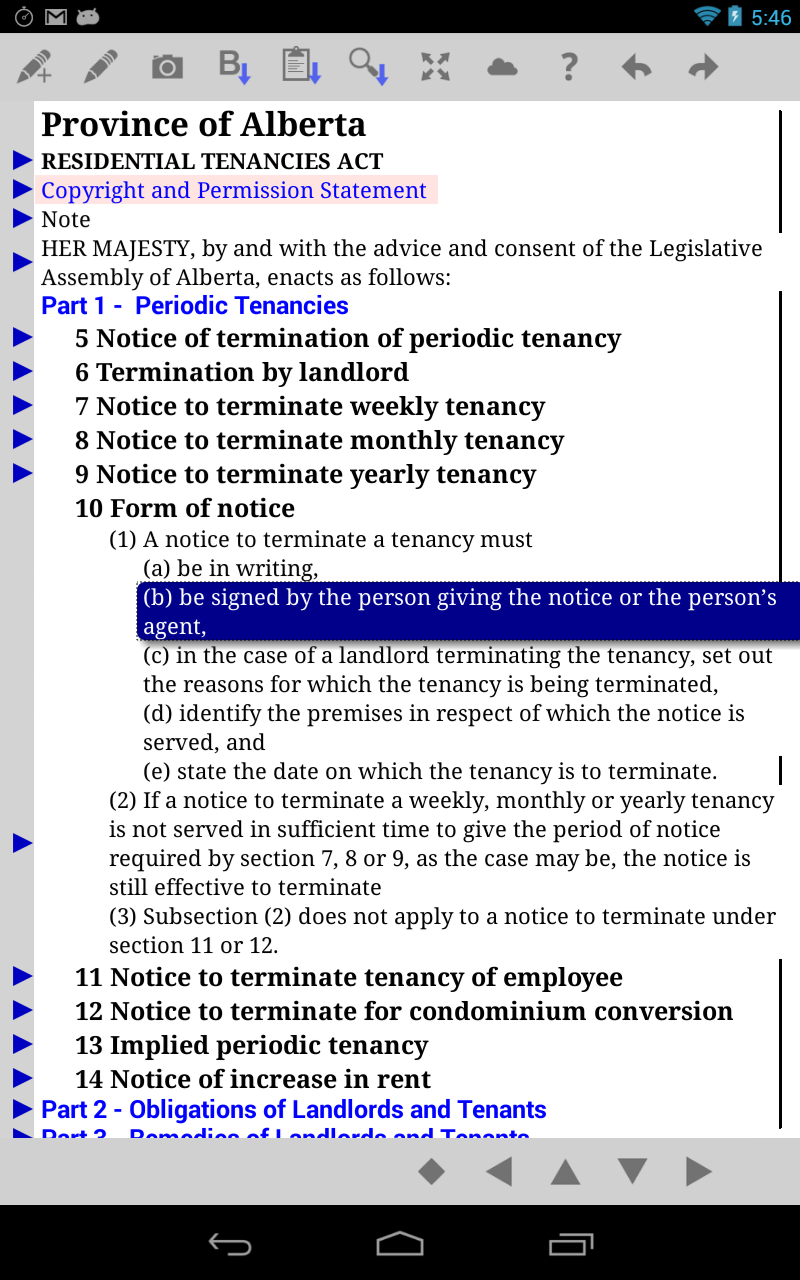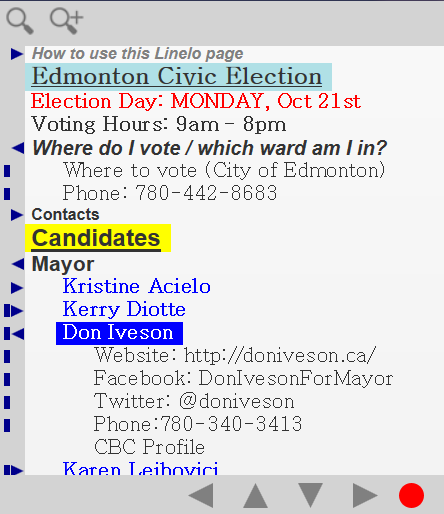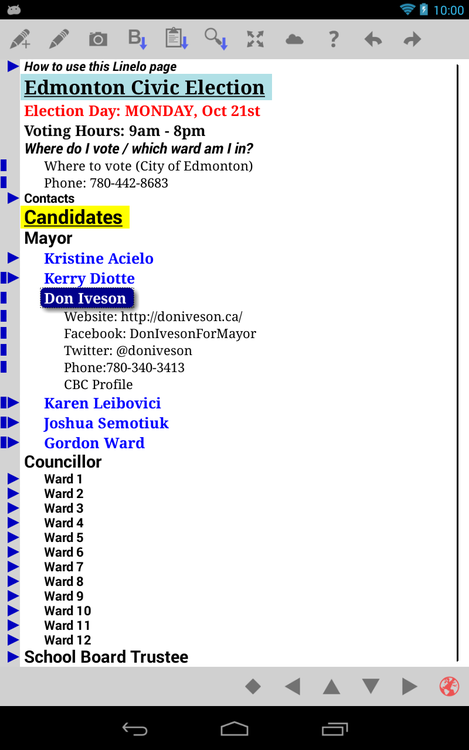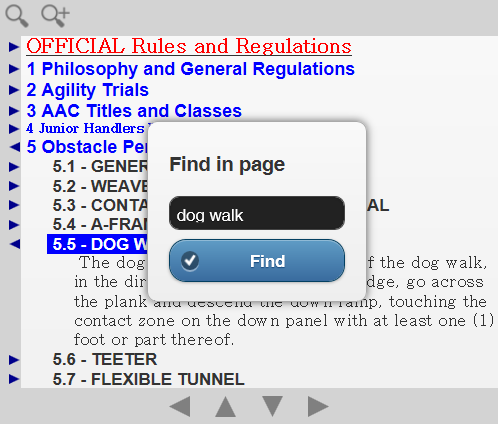Yesterday we put out a major update, with lots of small bug fixes and features, and one very significant new function. As you may recall, Linelo allows you to open public and shared files, such as http://linelo.net/yegcc. Then we added the 'store locally' function, which meant that the file would be stored on your phone/tablet, so so the device wouldn't have to go back to the cloud every time you wanted to see the file.
That left us with a couple of options as to how we would like the file to look. On the one hand, we could take away all the editing functions and make it a completely read-only file. This is pretty much the way the web works -- you access lots of web pages but they are always "look but don't touch". You can read them, but that's it.
We really don't like that option.
Even before the Internet came along, when you had to buy a book in paper form, you had the option to whatever you liked with the pages. You could underline passages, bend the corners on the pages to mark your spot, even rip pages out to take with you. (I remember more than once stepping into a telephone booth, grabbing the yellow pages, and finding the page I wanted had been ripped out by somebody else.) In short, the physical thing was yours, to do with as you please.
So our model is different. Once you pull the page down, you can edit it just like you would your own Linelo file. You can move lines around, add your own notes, delete stuff you don't care about, add some formatting, whatever you like.
Of course, this completely changes the relationship between author and reader. Especially for reference documents, the author can put in lots of stuff you don't care about. The reader then has the option to just keep the bits that are relevant.
Let's take an example.
The yegcc file lists all local politicians (mayor/councillor/trustee) for every ward in Edmonton, as well as all the unsuccessful candidates from the 2013 election. Now that the election is over, you might want to delete all stuff except the contact information for the representatives for your own ward, and be left with just a small, simple, useful file that allows you to send in requests to fix the potholes to just the right people.
Caveat...
But there is one caveat.
Let's suppose the original author of yegcc decides to add contact information for other city departments. Now you have to decide whether to grab the new version of the document or keep your original, whether to "refresh" your yegcc file. If you do this, all of your changes will be lost - replaced by the new version from the cloud. That's why there is a warning before your refresh the file, that any changes you have made will be lost.
If you have changes you want to keep, you can copy them into your own notes file before doing the refresh.
If you have LineloPro you will also have the option to "merge" the changes, so the effect of the refresh will be to combine the author's changes with yours. But that's a story for another day.
Wednesday, 30 October 2013
Friday, 25 October 2013
Facebook Terms of Service
Continuing in the legal documents mode, our document of the day is comprises Facebook's Terms of Service. If you're like us, the chances of reading documents like this are vanishingly small, even though you may use Facebook every day and knowing your rights and obligations is pretty very extremely important.
So imagine if the document looked instead like this:
Ok, maybe it still looks a bit intimidating, but in reality, Linelo makes documents like this very easy to read and navigate because in essence, it hides most of the content that you are not focused on at the moment, allowing you to focus on just one little piece at a time.
Maybe "fun" is a overstating the case a bit, but Linelo makes documents like this much more accessible. If there is a document like this that has public interest, send us a link and we'll consider making it into a public LineloNet document.
So imagine if the document looked instead like this:
Maybe "fun" is a overstating the case a bit, but Linelo makes documents like this much more accessible. If there is a document like this that has public interest, send us a link and we'll consider making it into a public LineloNet document.
Reworked Menu Structure
Today's update of the Linelo Android App (version 12 for those who care) is mostly cosmetic. The top menu system was getting a bit cluttered so we have updated so that it now looks like this:
The main change you will notice is that the formatting functions are up all the time now -- previously they were only available when the format menu was being shown. We've moved the Cloud function into a place of prominence and pushed the help button down to the bottom of the submenu.
The other major change here is the ability to "Refresh" LineloNet files. (Goto Files/Refresh). Under normal circumstances (as explained in the previous post) your device will store a local copy of any LineloNet files and use that instead of repeatedly going to back to the cloud to get the same content. This new change feature allows you to force the app to download a new version of the file so you can stay up to date.
Particularly for the home "Cloud" file, it is probably a good idea to do this regularly. One of our highest priority features is to check this for you, so you know whether you need to refresh the document or if the document is already up to date. But for now, checking once a day or so (depending on the file) is probably sufficient.
Thursday, 24 October 2013
Legal Documents
Linelo is amazing for presenting legal documents, it actually makes readable and interesting stuff that normally would only be interesting to a lawyer. And Linelo’s highly compact format makes it practical to reference legal docs on a tablet or even on a smartphone because it is easy to focus on just the bit of the document that is interesting to you at the moment.
Below is our first example of this — the Landlord and Tenant Act of Alberta (in Canada). As we usually do, the screenshot is taken from an older Nexus 7 tablet.
 |
| Landlord & Tenant Act of Alberta |
We’ve added nothing to this document - beyond converting to Linelo format and removing the redundant table of contents (Linelo doesn’t need those) all the content it is taken straight from the original.
If you are or have ever been a landlord or a renter, you can easily imagine how handy it would be have this with you, right at your fingertips should any questions about your legal obligations arise. Without Linelo you’re probably wading through websites, scanning pdf files, looking to find the relevant bits. Or worse, you’re contacting an expensive lawyer.
We’re just getting started with this stuff folks.
Faster, Cheaper, Better
Post 8 of 10 from the Tumblr Blog
Linelo for Android now caches web documents that are downloaded from linelo.net. Previously, the app pulled down the same document over and over, every time the doc was displayed. On today’s cheap, fast Internet this is actually okay for small files but… not so much the much bigger files that we plan to start releasing shortly.
Caching is pretty simple — it just means that the app stores a copy of the document somewhere on the smartphone or tablet rather than downloading it every time. That means lightning quick response times for documents that have been downloaded at least once, and no data charges are incurred after that first download.
It should be noted that because Linelo files are at heart just text files they are relatively tiny, about one tenth the size of a typical, very low resolution photo. So the actual download charges would be negligible.
Of course, adding features usually leads to new requirements and this is no exception. The documents in the cloud will change from time to time, and if the app is getting them locally instead of from the Linelo.net then those changes will never be seen.
So tomorrow we will release a version that has a ‘refresh’ button that allows you to check for new versions from time to time. (We’re just looking for the best place to put it, without cluttering up the existing menus.) The documents that are there now won’t change before this new version is released, so no updates will be missed.
If you’re wondering why we don’t check automagically in the background, we likely will do this down the road but we want to be very careful with that, as it might interfere with some amazing new features we have planned to release over the next couple of weeks.
Linelo for Android now reads Linelo.NET documents
This is post 7 of 10 from the Tumblr blog
As of today, when you use your Android device to click on a link that leads to a linelo.net document, you will be given the option to open the file in the Linelo application instead of in a web browser. Choose Linelo! The difference is between something that looks like this webapp rendition of (linelo.net/yegcc):

and this version as it appears in the Android App (on a Nexus 7 in this case):

And what the images can’t show you is just how much easier to navigate around in the Linelo App — much faster scrolling, ability to select and manipulate multiple lines at once, and the means to copy content from the public read-only document back to your own notes file.
You may notice that there are a couple of new icons in the top bar. The Help (?) icon opens up a help file, while the Cloud icon opens up the linelo.net index page — essentially a jumping off point to a variety of either linelo.net documents. Use the “Back” button to close these documents and get back to your own file.
linelo.net/jokes
This is post 6 of 10 from the Tumblr blog.
Our first attempt at Linelo web documents had long and not-very-pretty links that looked something like this:
It does work, and who cares if it’s not very pretty? Well for one thing it doesn’t look very nice but more importantly, it is so complex that no one would ever try and bring up a Linelo document just by typing the address directly. Imagine if you knew that Linelo had a jokes file (it does) and wanted to bring it up by typing in the url directly? Not a chance.
So today we have layered a proper naming convention over top of this, as well as moving the linelo.net domain over to be the primary host. That same jokes web document can now be accessed with this link:
Much, much better. This convention has the name in two parts: “public” is the account that owns the document, and “jokes” refers to the document itself. So all you need to remember is the account and the document title.
Wait, what? Account?
Ok, so Linelo allows anyone to create documents and there could be lots of different joke files, so Account allows us to pick the right one.
But for most public files we really shouldn’t ask users to remember even that much. So we’ve actually simplified it a bit even more for documents owned by the public account, and that same document can now also be retrieved with this link:
And your web browser will probably allow you to cut the typing down even further to just this:
Edmonton Civic Election 2013
This is post 5 of 10 to be brought over from the Tumblr blog.
If you’re like us, you like to do your civic duty and vote but you may not be sure what ward you’re in, the candidates seem like a bewildering array of people that you barely recognize, and it seems like a lot of work to decide on someone to vote for and to work out how and where to actually vote.
So we have help for you… in the form of the Edmonton Civic Election Linelo document/webapp. Here is what it looks like:

In it we have all the candidates across the city, with links to every website so with one click you can see what the candidate has to say. There’s a link to the City of Edmonton widget that tells you what Ward you live in, and where you should be voting. It even has Twitter, Facebook, and telephone links for the mayoral candidates (other candidates to come).
Over the next few days we’ll be adding the twitter and facebook links for the remaining candidates, as well as adding links to profiles, editorial commentary etc. related to each one.
Any comments or suggestions related to this are most welcome. Let’s vote Edmonton — Monday Oct 21st.
Find Now Works!
We’re trying not to overdo it with the functionality in the webapp/reader but some functions are critical for Linelo, particularly when you have documents that may contain several thousand lines and what you want may be buried a few levels down. Since the magic of Linelo is to be able to work effectively with documents of that size, Find functionality is a critical feature.
How is this different from the normal web browser find function? The difference is that Linelo searches through all the hidden lines, then opens up the containing lines to reveal the line that it found. The standard browser find function just searches those lines that are visible — the ones you can see anyway. The magnifying glass opens up the find dialog, while the the icon with the + repeats the find.
The find function always searches from the current line, so in the photo the search will actually start from the highlighted “5.5 - Dog…” line. To find lines above this you need to select a line at the top of the document. Also, the search is case insensitive — meaning a search for “dog” will match on “dog”, “DOG”, “Dog” and so on.
Try it out, let us know what you think.
The Web App is Up!
So, after a few days away, we have something really cool to talk about today. Until today, Linelo has been a mobile app that is locked in to just one platform (Android) for public users (we have versions for other platforms internally.) As I mentioned in the previous post that doesn’t really give us a way to let people know how Linelo is useful, and what it might be used for.
Today the new Linelo Reader web app is up. It allows everyone to take a look at Linelo files on their mobile web browsers simply by clicking a link. For example, here is a link to a Linelo document about Ingrid, the company car, otherwise known as the Linelomobile. This is the file that we actually use to maintain the car, it allows us to see specs for the car that might otherwise be hard to remember, keep a history of everything that has happened to the car, as well as keep up to date on maintenance.
A completely different type of file is this rulebook for the Agility Association of Canada. Agility is a sport that you do outside with your dog, and the AAC is a national organization with many thousands of members, many of whom would love to be able to check rules in the middle of a competition. This use of Linelo makes it possible for them to do that, just by keeping that link to the web app on their phone or tablet.
NB: the version we’ve linked to here is optimized for mobile devices — iPhone, iPad, Android etc. It works in a regular browser but just not quite as pretty. Hopefully within the next couple of days we’ll be able to get the tweaks in place to make it look just as nice on the desktop.
And please, if you have an Android device, check out the actual Linelo app. It is free, and amazingly powerful, and really is the best way to keep track of random bits of information on your phone.
Our Biggest Issue...
After three years or so of Linelo development (with time outs to work on other platforms) we’re pretty happy with the app itself. Our biggest issue now is how to promote it.
The question is not so much how to let people know that Linelo exists — that problem can simply be solved by throwing some ad dollars at it. Instead the question is how to let people know how Linelo can be used.
Like a word processor, Linelo essentially present the first time user with a blank piece of paper and some information about how to use it. But it’s value isn’t really apparent until you’ve been using it for a while. When you need to remember something and it’s in Linelo because you put it there this morning, last week, or last year.
We are going to use two different tactics to address this. First, we’re going to update the startup file to put some real content in it. Perhaps a bit of a grocery list, perhaps links to top movies or websites, maybe a bit of a calendar, that kind of thing.
Our other strategy is to create a series of apps that use the Linelo engine to encapsulate and present popular stuff. Our first attempt of this came last year, when we create and app called “Fringelo” which had all the listings and details for our local Fringe festival.
It was a quite a useful app, as it users could wander around the festival with all the listings in a very usable format on their phones. And it allowed us to show just how valuable Linelo can be for packing large amounts of information in a way that makes it highly presentable even on the relatively tiny screen of a phone or tablet.
So look for a bunch more of these apps to be coming out in the near future. With the first few we’ll try a few different domains; we’re planning to do one of our favorite plays (Hamlet), a legal document (the Landlord and Tenant Act), and the top 500 (number subject to change) movies of all time. We’re also looking at building these apps for large organizations. It’s great for putting out standards such as safety procedures for companies that have construction sites for example.
Of course we’re open to suggestions — if you have an idea for an app that can be built from the Linelo engine, please pass your suggestion along to me — terry.oneill@linelo.com.
In the meanwhile, we’ll announce the new apps as we build them here and on Twitter. Hopefully we’ll have a couple out by the end of this week.
Where We Are - Sept 25, 2013
Back in September we started a 'blog' over on Tumblr -- you can see it here -- mainly because we were having trouble getting Google+ to play with our linelo.com domain. We've got that sorted now, but we really don't want to lose that month of posts so we're coping them over manually. So if any date references look a little odd, now you know why...
So we’ve been the tank for a while working on the best way to get this Linelo thing off the ground - the result is a bit of a reorganization in the way we are going set the Linelo product family.
If you are new to Linelo you can skip this post entirely — it is mainly for those who have been using the many incarnations of Linelo for Android, Windows, and the web. We’ll have a separate announcement for new users shortly.
In any event, we’ve kind of gone back to the beginning and created an entirely new version of Linelo for Android. It has some new and exciting features that Linelo didn’t have — font sizes and types for example — but it has also lost some things. In particular, it only works on one file, and there is no way to sync that file anywhere.
This limitation is because we are positioning this version of Linelo as kind of a “light” version. We’re trying to keep it really simple and straightforward so that new users can focus on the basic stuff — entering lines and moving them around — without getting into a bit of a learning curve. We see it as being used for lightweight notes, such as grocery lists, things to remember for today, project ideas and such.
The more advanced features of Linelo are going to be moved into an application that we will call LineloPro. The main difference is that this will be the version that enables you to create lots of different files and to sync them with a server, publish them to the web, share and collaborate with others, and all that other fun stuff.
So our game plan right now is to release Linelo (i.e. the light version) which we’ve done today (Sept 25) and then to move on to the Pro version, which should follow by a couple of weeks. At that point we will probably work on the mobile web version, so that iOS and web users can join in the fun.
Subscribe to:
Posts (Atom)



